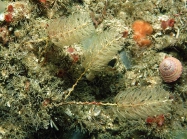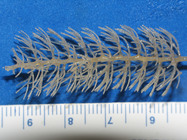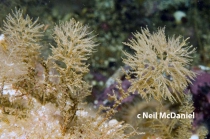
| Introduction | | Search taxa | | Taxon tree | | Taxon match | | Checklist | | Literature | | Stats | | Photogallery | | OBIS Vocab | | Log in |
CaRMS taxon detailsThuiaria Fleming, 1828
117237 (urn:lsid:marinespecies.org:taxname:117237)
accepted
Genus
Selaginopsis Allman, 1876 · unaccepted (synonym)
marine,
Fleming, J. (1828). A history of British animals, exhibiting the descriptive characters and systematical arrangement of the genera and species of quadrupeds, birds, reptiles, fishes, Mollusca, and Radiata of the United Kingdom; including the indigenous, extirpated, and extinct kinds, together with periodical and occasional visitants. <em>Edinburgh, Bell & Bradfute / London, James Duncan.</em> Pp. i-xxii, 1-565. corrigenda., available online at http://www.biodiversitylibrary.org/item/18569
page(s): 545 [details]
Status Salacia Lamouroux, 1816 and Thuiaria Fleming, 1828 have at times been regarded as congeners, although they are currently...
Status Salacia Lamouroux, 1816 and Thuiaria Fleming, 1828 have at times been regarded as congeners, although they are currently held to be distinct. A key difference in terms of morphology is the presence of an abcauline diverticulum or caecum (Millard 1975, fig. 81A) in Thuiaria and its absence in Salacia. (Calder & Faucci, 2021) [details]
Schuchert, P. (2024). World Hydrozoa Database. Thuiaria Fleming, 1828. Accessed through: Nozères, C., Kennedy, M.K. (Eds.) (2024) Canadian Register of Marine Species at: https://www.marinespecies.org/carms/aphia.php?p=taxdetails&id=117237 on 2024-04-20
Nozères, C., Kennedy, M.K. (Eds.) (2024). Canadian Register of Marine Species. Thuiaria Fleming, 1828. Accessed at: https://www.marinespecies.org/carms/aphia.php?p=taxdetails&id=117237 on 2024-04-20
Date action by
original description
Fleming, J. (1828). A history of British animals, exhibiting the descriptive characters and systematical arrangement of the genera and species of quadrupeds, birds, reptiles, fishes, Mollusca, and Radiata of the United Kingdom; including the indigenous, extirpated, and extinct kinds, together with periodical and occasional visitants. <em>Edinburgh, Bell & Bradfute / London, James Duncan.</em> Pp. i-xxii, 1-565. corrigenda., available online at http://www.biodiversitylibrary.org/item/18569
page(s): 545 [details] original description (of Selaginopsis Allman, 1876) Allman, G. J. (1876). Diagnoses of new genera and species of Hydroida. <em>Journal of the Linnean Society of London.</em> 12: 251-284, plates 9-23., available online at https://www.biodiversitylibrary.org/page/31981814 page(s): 272 [details] context source (Hexacorallia) Fautin, Daphne G. (2013). Hexacorallians of the World. (look up in IMIS) [details] basis of record van der Land, J.; Vervoort, W.; Cairns, S.D.; Schuchert, P. (2001). Hydrozoa, <B><I>in</I></B>: Costello, M.J. <i>et al.</i> (Ed.) (2001). <i>European register of marine species: a check-list of the marine species in Europe and a bibliography of guides to their identification. Collection Patrimoines Naturels,</i> 50: pp. 112-120 (look up in IMIS) [details] additional source Liu, J.Y. [Ruiyu] (ed.). (2008). Checklist of marine biota of China seas. <em>China Science Press.</em> 1267 pp. (look up in IMIS) [details] Available for editors additional source Hansson, H. (2004). North East Atlantic Taxa (NEAT): Nematoda. Internet pdf Ed. Aug 1998., available online at http://www.tmbl.gu.se/libdb/taxon/taxa.html [details] Available for editors redescription Peña Cantero, A.; Svoboda, A.; Vervoort, W. (1997). Species of Staurotheca Allman, 1888 (Cnidaria: Hydrozoa) from recent antarctic expeditions with R. V. Polarstern , with the description of six new species. <em>Journal of Natural History.</em> 31(3): 329-381., available online at https://doi.org/10.1080/00222939700770171 page(s): 338; note: emended diagnosis, status, species included [details]  Present Present  Inaccurate Inaccurate  Introduced: alien Introduced: alien  Containing type locality Containing type locality
From editor or global species database
Diagnosis Colonial hydroids of pinnate (branches and/or hydrocladia alternately arranged in one plane), palmate (colony has a main stem with largely ascending, long branches, converging strictly to loosely in one plane) or tree-like (branches in a loose spiral along length of stem) appearance; anastomoses rare. Hydrothecae cylindrical, slightly to distinctly outward curved, of the same diameter throughout or slightly wider basally, completely or partially immersed into stem or branch; adcauline hydrothecal wall usually almost completely adnate; abcauline wall with thickening under place of attachment of operculum. Hydrothecal rim circular (with the exception of Thuiaria gonorhiza Naumov, 1952); hydrothecal operculum composed of a single circular plate with abcauline attachment. Hydrothecae on stem arranged in opposite or subopposite pairs; number of rows of hydrothecae on stem two, falling in one plane [however, with the exception of Thuiaria arctica (Bonnevie, 1899) and Thuiaria zachsi Fenyuk, 1947!]. On the branches the arrangement of hydrothecae is also in pairs (as in the stem) or in decussate verticils of which the number of hydrothecae remains constant or is increased, three or more hydrothecae per verticil being observed, number of longitudinal rows of hydrothecae twice that number. Hydranth with abcauline caecum. Gonotheca ovoid to elongate-ovoid, inserting on stem or branches directly under a hydrotheca, usually longitudinally arranged. Gonophore a sporosac, in many species producing a marsupium outside gonotheca; certain species have curbed spiniform projection on apical part of gonotheca forming an external chamber (pseudomarsupium). Colonies dioecious; with sexual dimorphism. [details] Status Salacia Lamouroux, 1816 and Thuiaria Fleming, 1828 have at times been regarded as congeners, although they are currently held to be distinct. A key difference in terms of morphology is the presence of an abcauline diverticulum or caecum (Millard 1975, fig. 81A) in Thuiaria and its absence in Salacia. (Calder & Faucci, 2021) [details] |



